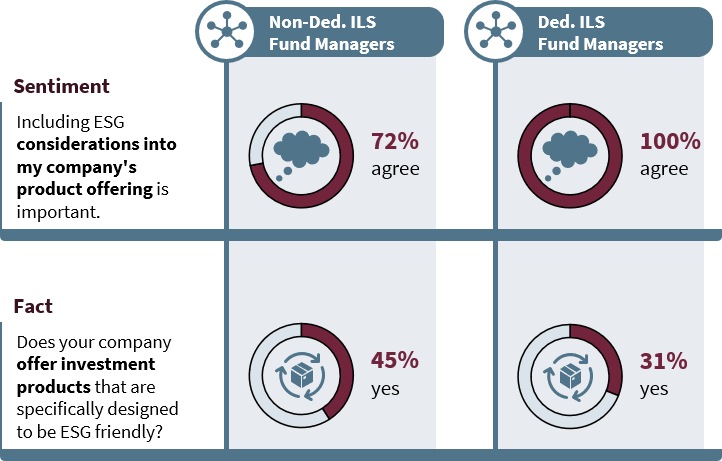Last December, we at Synpulse and leading ILS news provider Artemis published an ESG Study on how risk transfer market players are integrating environmental, social, and governance (ESG) factors into their strategies and operations. In the first two articles, we saw that while companies are interested in embedding ESG into their operating models, certain obstacles commonly prevent them from doing so. This time we look at how companies in the marketplace are incorporating ESG into their underwriting and investment processes as well as products. The picture is by no means consistent.
Underwriting standards and guidelines
Underwriting standards and guidelines are a way for a company to steer its business in alignment with its risk appetite by defining desired and non-desired risks. As such, these standards and guidelines serve as a link between ESG strategy and operational implementation and are closely intertwined with product development (more about that later in this article).
The survey finds that most (76%) players in the risk transfer market integrate ESG criteria into their underwriting standards and guidelines to help them steer ESG compliance during the underwriting process. However, a more detailed breakdown of the findings reveals major differences between segments: while almost all insurers integrate ESG into their underwriting standards and guidelines, only just over half of the reinsurers do so, possibly reflecting reinsurers’ own assessment (discussed in our first article) that they lag behind their competitors in terms of implementing ESG strategy. The favoured approach of survey respondents for putting ESG-compliant underwriting standards and guidelines into practice is to exclude non-desired clients, projects, industries, or geographies.

Insurance products
Overall, 96% of the surveyed players claim to offer insurance products that can be considered particularly ESG-friendly. This is somewhat surprising given that survey participants are on average not very advanced in terms of implementing an ESG strategy. It may be a sign of greenwashing: companies are promoting products as ESG-friendly when in fact they are not.
The survey finds that more than 60% of all allegedly ESG-friendly insurance products focus on the «S» (social) component of ESG – for example natural catastrophe (NatCat) insurance – with less emphasis on the «E» (environmental) component. The assertion that NatCat is more about the social than the environmental component may seem illogical. But you have to remember that NatCat insurance does not help fully address the root causes of natural catastrophes themselves; it has more to do with the resilience of insured risks in the face of natural catastrophes.
Investment products
For ILS fund managers underwriting considerations are important too but one needs to look at the offered investment products and the extent to which ESG considerations are incorporated as well. As we have seen in other areas covered by the survey, a major discrepancy between sentiment (aspiration) and fact is also observed here. On average, 92% of all fund managers agreed that including ESG considerations in the product offering is important. But the percentage actually offering investment products specifically designed to be ESG-friendly falls way below this:

Earlier in the survey, respondents stated that one of the factors driving the incorporation of ESG factors was investor desire. So why is there such a wide gap between the perceived need for ESG-friendly investment products and the actual offering? It might be because only a minority of fund managers have implemented an effective ESG strategy in the first place.
Can an investment product offering be ESG-friendly if there is no effective ESG strategy incorporated into the operating model? We think not. Again, the message is clear: companies that are serious about putting their ambitious ESG aspirations into practice and have not yet formalised and operationalised their ESG strategy need to consider tackling ESG using a bottom-up approach starting with their strategy and set about filling the gaps.
Whatever the case, fund managers have some catching up to do if they are truly going to deliver on their promise to investors. For fund managers subject to the SFDR, considerations in respect of ESG friendly products have to be made anyways – no matter whether they want to offer an ESG-friendly product or not. Hence, there is no better time to think about an ESG friendly product than now.
Conclusion: Address the gap between ESG aspiration and practice – otherwise you might soon be facing a major credibility gap or even regulatory ramifications.
Once again, this section of the survey – covering the actual implementation of ESG factors in underwriting and investments processes as well as products – reveals inconsistencies and gaps between what players in the risk transfer market aspire to and what they actually deliver. In an environment where investors are increasingly demanding ESG to be embedded into underwriting decisions and investment offerings and regulators are pushing for more ESG disclosure, risk transfer market players should consider this as an opportunity to step up and show their true level of ESG commitment.
Stay tuned to find out about progress in another key practical area: training, reporting and communication on ESG in the risk transfer market.
These were only the bare bones of our survey findings and interpretations. To find out more, sign up to receive a download of the market study or contact us directly.
